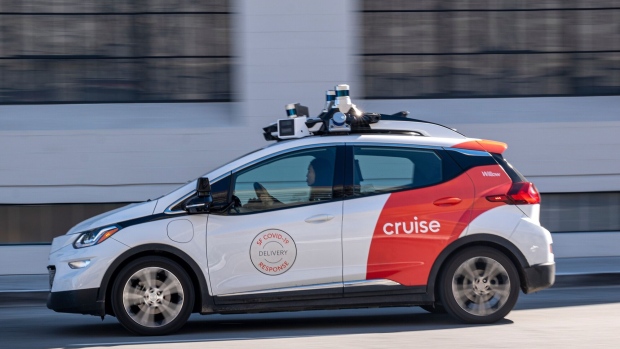Apr 9, 2024
GM’s Cruise to Resume Testing Its Robotaxi Service in Phoenix
, Bloomberg News

(Bloomberg) -- General Motors Co.’s Cruise autonomous driving business is preparing to resume testing its robotaxis with safety drivers in Phoenix, marking an important step in its attempts to restart service after grounding its fleet last year.
The company said Tuesday that it will begin collecting road information in certain cities, starting with Phoenix. In recent months, Cruise has been in talks with officials in 20 metropolitan areas where it previously operated cars in preparation to lay the foundation for eventual robotaxi service. Phoenix is a natural place to start as Cruise already has vehicles in the area and city officials were open to the idea of its return, said a person familiar with the plan, who asked not to be identified.
“Cruise is resuming manual driving to create maps and gather road information in select cities, starting in Phoenix,” Cruise spokesman Pat Morrissey said in an email, confirming an earlier Bloomberg report. “This work is done using human-driven vehicles without autonomous systems engaged and is a critical step in validating our self-driving systems as we work towards returning to our driverless mission.”
Getting Cruise back on the road is important for GM Chief Executive Officer Mary Barra, who has pledged to take the carmaker to leadership in electric vehicles and self-driving technology during her tenure. The robotaxi business was supposed to be a key part of her goal to double revenue to $280 billion by 2030. With Cruise’s problems and a slowdown in EV sales growth, that target looks tougher to reach.
GM shares rose 0.7% to $44.65 at 12:50 p.m. in New York. The stock advanced 23% this year through Monday.
Once Cruise has collected the data and mapping information it needs, the next step is to test the vehicles, still with human drivers behind the wheel to validate the system. During that phase, the Cruise vehicles will drive themselves with a safety driver present to monitor and take over if needed.
The robotaxi company has been working to earn the public’s confidence after one of its cars struck and dragged a pedestrian in San Francisco in October. Following the incident, California regulators alleged that Cruise initially withheld key footage and details of the incident, which ultimately resulted in the suspension of Cruise’s license in California.
After that, Cruise suspended all operations nationwide, took the resignation of founder and former CEO Kyle Vogt, dismissed nine top executives and laid off a quarter of its workforce. The company later hired a new chief safety officer.
In recent months, the company also established a regulatory team to guide engagement with regulators in regard to incident reporting and has reviewed and added to its internal safety processes, the company said in a blog post.
Read more: GM’s Cruise Prepares to Resume Robotaxi Testing After Halt
Getting back on the road will be just the first move in a long road to recovery for Cruise. When the October incident occurred, Cruise was charging fares in San Francisco, Austin and Phoenix. The company was also gathering data in preparation to eventually launch across the US, with Atlanta, Seattle, Miami, and Raleigh, North Carolina, possibly following cities in Texas.
(Updates with testing details in the third paragraph)
©2024 Bloomberg L.P.





